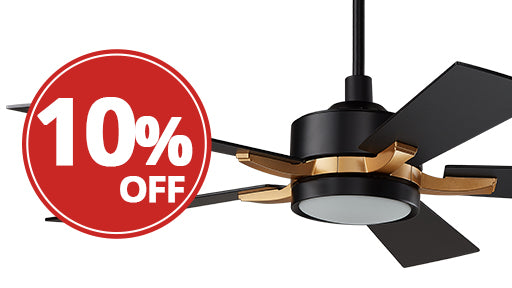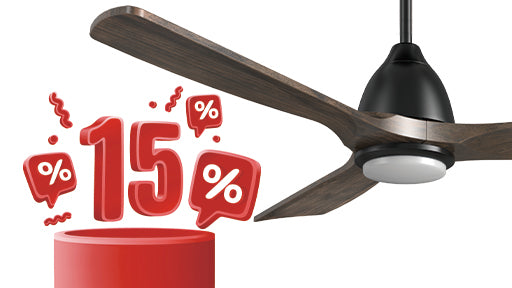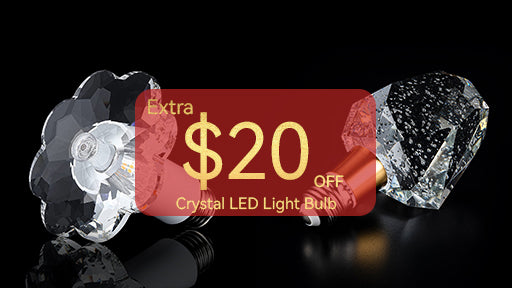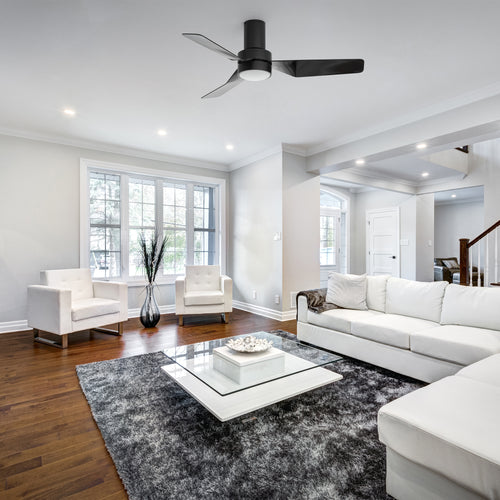Choosing the right light bulbs for your ceiling fan is more critical than you might imagine. The lighting in your living space can significantly impact the atmosphere at home and even your health. Therefore, picking the right bulbs for your ceiling fan can be a game-changer. This comprehensive guide will help you understand light bulb sizes, ceiling fan bulb types, and how to choose the best one for your needs.
Understanding the Different Types of Light Bulbs
Light Bulb Types
Light bulb types include halogens, fluorescents, incandescent, and more. However, for ceiling fans, you'll only need to focus primarily on two types: incandescent and LED bulbs.

Incandescent Bulbs
Incandescent bulbs are an older style of light bulb known for their warm yellow glow. They are compatible with dimmer switches and are amongst the most affordable bulbs on the market. However, they use more energy than newer types and have a shorter lifespan, needing to be replaced more often.

LED Bulbs
LED ceiling fan bulbs have gained widespread popularity, primarily for their exceptional energy efficiency and eco-friendly attributes. These bulbs are designed to provide greater lumens output at a lower wattage compared to their incandescent counterparts. This efficiency translates into a significantly extended lifespan, ensuring long-term use with fewer replacements. Additionally, LED bulbs exhibit impressive resistance to fluctuations in temperature and humidity levels, making them more versatile across various environments. A notable advantage of using LED bulbs in ceiling fans is their minimal heat emission, which stands in stark contrast to the higher heat output of incandescent bulbs. This feature not only enhances the comfort in a room but also contributes to a safer and more energy-conserving lighting solution.
Decoding the Bulb Base and Size
Light Bulb Base Sizes
Light bulb bases come in a variety of sizes. The size is indicated by a combination of letters and numbers, referred to as light bulb codes. The letters in a bulb code indicate its shape and the numbers denote the size, based on its diameter at its widest point, measured in eighths of an inch (⅛”). Common bulb base sizes include E11, E12, E17, and E26 bulb base.
The E26 medium screw base is a standard choice for numerous ceiling fans in the United States. However, it's essential to examine your particular fan fixture to ensure compatibility, especially if you own an older ceiling fan model. Different fans may require various bulb bases, so verifying the appropriate base for your ceiling fan's light bulb is a crucial step for the right fit and optimal performance.

Light Bulb Sizes
The size of a light bulb is represented by a letter/s and a number/s. The letter represents the shape of the bulb, while the number indicates the diameter of the bulb, measured in eighths (1/8) of an inch. For example, with an A19 bulb, 'A' indicates the classic, rounded shape, and '19' is the diameter, which equates to 19/8 or 2.375 inches. Refer to the standard light bulb size chart for your reference.

Choosing the right ceiling fan light bulb
Consider the Room Size and Ceiling Height
When selecting a light bulb for a low-profile ceiling fan, it's important to consider the distance between the fan and the ceiling. For rooms with low ceilings, opting for low-profile bulbs can ensure even, glare-free lighting without the bulbs protruding excessively, which can affect both aesthetics and safety. In smaller spaces, lower-wattage bulbs might be necessary to avoid overpowering light, while larger rooms may benefit from brighter bulbs to adequately illuminate the area. Choosing the right bulb is essential not only for effective lighting but also for the overall interior design and comfort of the room.
Look at the Lighting Needs
When choosing light bulbs for your ceiling fan, it's important to assess the room's lighting requirements. If the fan serves as the main light source, select a bulb that offers higher wattage for broader illumination. For a cozier atmosphere, lower-wattage bulbs are ideal, and dimmable ceiling fan bulbs provide the flexibility to adjust light levels to suit any mood or occasion.
Think Energy Efficiency
Energy efficiency should also be a key factor in your decision. LED bulbs are highly efficient and have a longer lifespan, making them a cost-effective and eco-friendly option for ceiling fan lighting. They use less power than traditional incandescent bulbs, leading to potential savings on electricity bills over time.
Decorative Purposes
The light fixture of your ceiling fan can enhance the room's decor. Consider styles with visible bulbs or those that include light covers, such as bowl shapes or glass shades. These elements should not only complement the overall design of your home but also add a touch of elegance and personality to your space.
The Role of Lumens and Wattages in Light Bulbs
Understanding Lumens and Wattages
Lumens and wattages play a significant role in determining the performance of light bulbs. Lumens indicate the brightness of the bulb, with higher lumens producing brighter light. Wattages, on the other hand, indicate the energy consumption of the bulb. Opt for bulbs with higher lumens for areas that require more light, such as living rooms or kitchens. For areas where softer lighting is desired, such as bedrooms or dining rooms, choose bulbs with lower lumens.

Maximum Wattage on Lighting Fixture
It's crucial to adhere to the maximum wattage indicated on your ceiling fan’s lighting fixture. Exceeding this wattage limit can lead to electrical safety issues.
Color Temperature and Quality of Light Bulbs
Understanding Light Color Temperature
Color temperature refers to the warmth or coolness of the light emitted by a bulb. It is measured in Kelvins and ranges from warm (2700K-3000K) to cool (5000K-6500K). Warm light creates a cozy and inviting atmosphere, while cool light is more energizing and suitable for task-oriented spaces. Consider the purpose of the room and the desired ambiance when selecting the color temperature of your ceiling fan light bulbs.

Considering Light Quality
Opting for high-quality bulbs like LEDs can be more economical in the long run due to their energy efficiency and longevity. Cheaper bulbs might save money initially but tend to have a shorter lifespan.
Dimmable Light Bulbs for Ceiling Fans
If you prefer to have control over the brightness of your ceiling fan light, consider opting for dimmable bulbs. Dimmable bulbs allow you to adjust the lighting intensity to create the perfect ambiance for any occasion. However, it's important to ensure that your ceiling fan is compatible with dimmable bulbs. Not all fans are designed to work with dimmer switches, so check the fan's specifications or consult a professional electrician before making your purchase.
Best practices for replacing light bulbs in ceiling fans
When replacing light bulbs in your ceiling fan, ensure safety and avoid damage by following these best practices:
-
Turn Off the Fan: Always make sure the fan is switched off before you start.
-
Let Bulbs Cool: Wait until the bulbs are cool to the touch to avoid burns.
-
Safe Reach: Use a ladder or step stool to reach the bulbs safely.
-
Removing Stubborn Bulbs: If bulbs are difficult to remove, use a cloth or gloves for a better grip.
-
Secure New Bulbs: Properly screw in the new bulbs to prevent issues like flickering.
Additionally, if your maintenance requires removing the light kit from the ceiling fan, it's important to follow specific steps to do this safely and effectively. For a detailed guide please refer to How to Remove Ceiling Fan Light Kit. This resource will provide you with step-by-step instructions and helpful tips to ensure a smooth and safe process.
Energy-Efficient LED Light Bulbs
For an eco-friendly lighting choice, LED ceiling fan bulbs stand out as an excellent selection for ceiling fans. Notably, they generate considerably less heat compared to conventional incandescent bulbs, enhancing their safety profile for use in ceiling fan fixtures. Additionally, their energy-efficient nature translates to cost savings over time due to reduced energy consumption and their extended lifespan. This makes LED bulbs not only a practical option but also a financially sound investment in the long run.
Conclusion: Finding the perfect light bulb size for your ceiling fan
Choosing the right light bulb for your ceiling fan is essential for creating the perfect lighting and ambiance in your space. By understanding the different types of light bulbs, base sizes, and factors to consider, you can make an informed decision. Take measurements, refer to light bulb size charts, and consider factors such as lumens, wattages, color temperature, and dimmability. By following these guidelines and best practices for replacing bulbs, you can find the perfect light bulb size for your ceiling fan and enjoy optimal lighting for years to come.
Remember, the right light bulb can transform your space and enhance its functionality. So, take the time to explore your options and select the perfect light bulb for your ceiling fan.
Product Recommendations

52" Visalia smart ceiling fan with dimmable LED light (Outdoor/Indoor)
Fan with a white-body design and a gold decorative circle setting above the lampshade, matching with white short flannel sofa, and large semicircular dark wood grain coffee table, showing the living room luxury.

56 inch Essex Outdoor ceiling fan with LED light and Remote Control
An outdoor patio with the SmaFan Essex 56-inch ceiling fan with LED light, wood-textured blades, and matte black finish on a white-paneled ceiling. Overlooking a lake with wicker furniture and beige cushions.

Skobeloff Smart Ceiling Fan with Light and Remote 52 inch
Modern living room featuring the Skobeloff 52-inch smart ceiling fan with three sleek black blades, a matte black finish, and an integrated LED light. The room includes a contemporary design with a gray-tiled electric fireplace, white walls, and large windows.




















